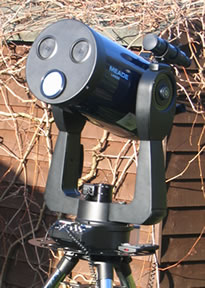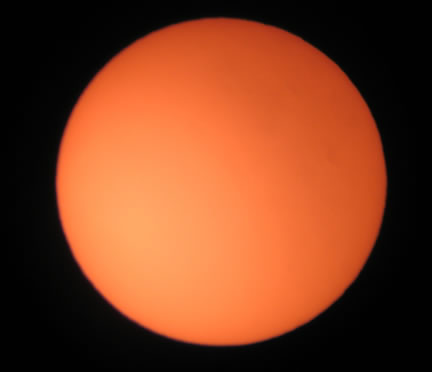Observing the Sun with the LX200
I recently purchased a second hand Hartmann mask together with an ETX90 solar filter from astrobuysell. Today I had my first chance to try it out and view the sun.
 The Hartmann mask covers the front of the LX200, just like the telescope cover. It contains three screws which are tightened so that the mask cannot be accidentally removed or fall off. The solar filter screws into one of the masks three viewing holes. The glass solar filter is actually designed primarily for use by the ETX90 telescope.
The Hartmann mask covers the front of the LX200, just like the telescope cover. It contains three screws which are tightened so that the mask cannot be accidentally removed or fall off. The solar filter screws into one of the masks three viewing holes. The glass solar filter is actually designed primarily for use by the ETX90 telescope.
I had no idea of how to get the LX200 and autostar to find and keep track of the sun. I had never used the telescope before in the daytime. I began by letting the LX200 go through it’s set up procedure and then just pressed ‘Enter’ when it asked me to align to the brightest star. I then looked on Starry Night Pro for a star near to the Sun, and selected that.
It was difficult to know where the telescope was pointing, so I also looked on Starry Night Pro to find out the RA and Dec positions of the Sun. I then entered these into Autostar and had the telescope slew to this position. After a little tweaking I found the Sun in the eyepiece.
I initially decided I was only going to view the Sun through my Philips web cam, but after not being able to get an image through the web cam I decided to view the sun through the eyepiece using my 40mm Antares eyepiece.
I had already fitted my f/6.6 focal reducer to the telescope which allowed me to view the whole disc of the sun in the eyepiece.
I then swapped out the eyepiece and inserted my webcam, but did not manage to get the sun to display on the laptop, nor did I manage to use my Canon DSLR to get some images. So instead I just put my Canon IXUS up to the eyepiece and took a photo, and here it is:
As you can see there are no distinguishing marks on the image, perhaps some new filters will change this, as I have been reading a lot about H-alpha pass filters and Solar Continuum filters.

